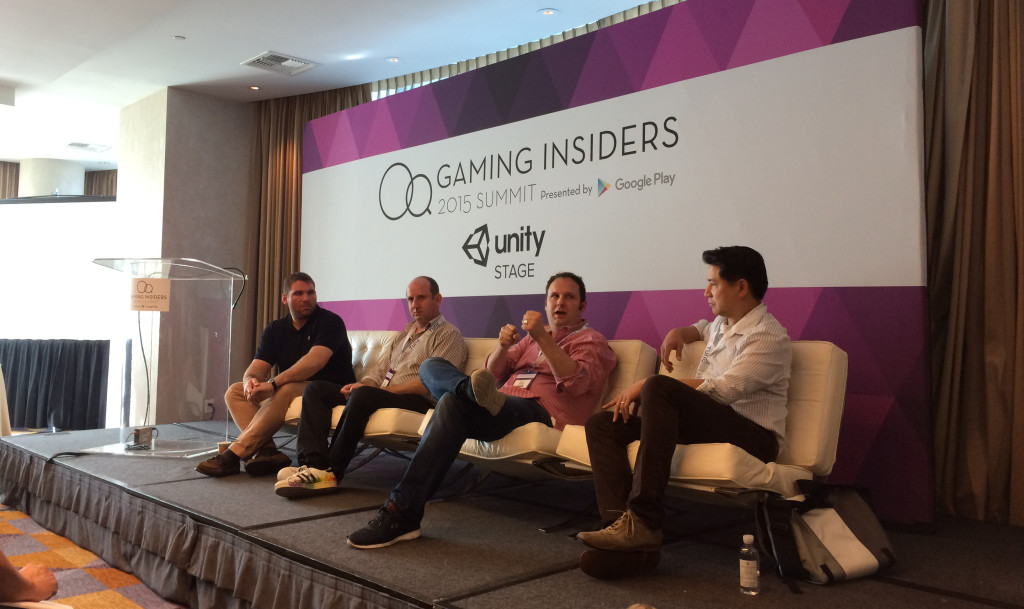At the Gaming Insiders Summit, one of the sessions was particularly well-attended Alternative Growth Strategies for Mobile Games. That really wasn’t a surprise given the experts in the session. The panel, moderated by Rovio’s VP of user acqusition Eric Seufert, included Terence Fung, the chief strategy officer for mobile game publisher Storm8, Simon Hade, COO and co-founder of Space Ape, and Andrew Stalbow, CEO and co-founder of Seriously.
The issue at hand was clear. “We’ve got to find much more effective ways of cutting through than traditional performance marketing,” said Stalbow: He noted that Seriously has found it effective to “go where others aren’t” and pointed out the company’s use of YouTube, which many had told them was a bad place to go for finding users. Stalbow took that as a challenge, and Seriously has found success on that channel by being creative.
As an example, Stalbow said they challenged PewDiePie and five other top YouTubers to see how far they could get in Seriously’s launch game, Best Fiends, in only one week. The incentive was that winner would see $50,000 donated to their favorite charity and, of course, serious bragging rights over other YouTubers. “It was a huge success,” noted Stalbow, with Best Fiends getting a great lift from the millions of YouTube views that generated.
Space Ape founder Simon Hade explained that his company has a three-person UA team doing straight performance marketing but they also have a 20% innovation budget. “It’s important to keep trying different things,” Hade said. The techniques available are always changing, and what’s working well at one point won’t be as efficient as more companies discover it and pour money into it. So it’s a constant search for the latest, most efficient ways to acquire new users.
Hade believes that YouTubers and streamers are increasingly important as a way to find and engage new users. “A quarter of the company [Space Ape] is doing customer support and engagement,” noted Hade. “We’re treating influencers like a PR channel,” he added, explaining that it’s a very cost-effective way to find users for Space Ape games.
Terence Fung of Storm8 noted that there strategy is somewhat different due to the different nature of their company. In contrast to Seriously, which currently has one game on the market, Storm8 has over 50 games so they don’t focus on any one game. “We spend about 10-30% of our marketing budget testing new UA channels,” explained Fung, though he later clarified that is usually more near the 10% end most of the time. How important is user acquisition to mobile companies Fung made that clear when he said this: “We spend a significant amount of our profits on UA, like most companies in the industry.”
One thing was quite clear from the varied experiences discussed by the panel: There’s no one solution for every game and every company. “If you’re trying to promote your game on a mobile device, you’re up against every entertainment product,” Stalbow pointed out, noting that you have video, music, social networks, books and more available on your game-playing mobile device, with all of those distractions only a click away. “You have to do multiple things at the same time: UA, a buy on Instagram, YouTube, a partnership with Wade Media, TV buy,” Stalbow advised. Of course, as Suefert pointed out, that brings in the issue of performance analytics. When you get creative about how you’re acquiring users, how do you track your performance Stalbow acknowledged that it’s more difficult. “We’ll see a collective result of revenue we bring in against that marketing push,” Stalbow said..
There’s some general advice the panelists offered that most marketers could use. “We’re a mid-size developer in a space where three or four developers are spending a million dollars a day,” Hade pointed out. “If you don’t concentrate your spend, it’s hard to see any result.” Hade is also sold on the importance of a fast start with your game. “I’m still a big believer in launch momentum. If I could have I would have loved to spend more on the launch of our games,” Hade said. Although he is hesitant about the value of television advertising for smaller companies. “TV is prohibitive for small developers. You can’t do a $200K or $300K TV campaign and get significant results,” he said.
As a final note, Stalbow had some cogent advice for marketers: “You have to be creative, and you have to takes risks classic performance marketing is a race to the bottom.” It’s time for marketers to be at least as creative as the game designers, as both should work together to attract, engage, and retain the biggest audience for their games.

